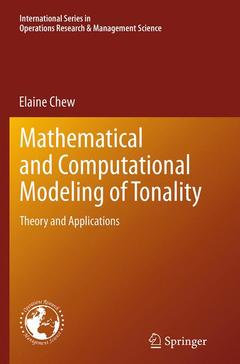Mathematical and Computational Modeling of Tonality, 2014 Theory and Applications International Series in Operations Research & Management Science Series, Vol. 204
Auteur : Chew Elaine

From the Preface:
Blending ideas from operations research, music psychology, music theory, and cognitive science, this book aims to tell a coherent story of how tonality pervades our experience, and hence our models, of music.
The story is told through the developmental stages of the Spiral Array model for tonality, a geometric model designed to incorporate and represent principles of tonal cognition, thereby lending itself to practical applications of tonal recognition, segmentation, and visualization. Mathematically speaking, the coils that make up the Spiral Array model are in effect helices, a spiral referring to a curve emanating from a central point. The use of ?spiral? here is inspired by spiral staircases, intertwined spiral staircases: nested double helices within an outer spiral.
The book serves as a compilation of knowledge about the Spiral Array model and its applications, and is written for a broad audience, ranging from the layperson interested in music, mathematics, and computing to the music scientist-engineer interested in computational approaches to music representation and analysis, from the music-mathematical and computational sciences student interested in learning about tonality from a formal modeling standpoint to the computer musician interested in applying these technologies in interactive composition and performance. Some chapters assume no musical or technical knowledge, and some are more musically or computationally involved.
Date de parution : 08-2016
Ouvrage de 305 p.
15.5x23.5 cm
Date de parution : 12-2013
Ouvrage de 305 p.
15.5x23.5 cm
